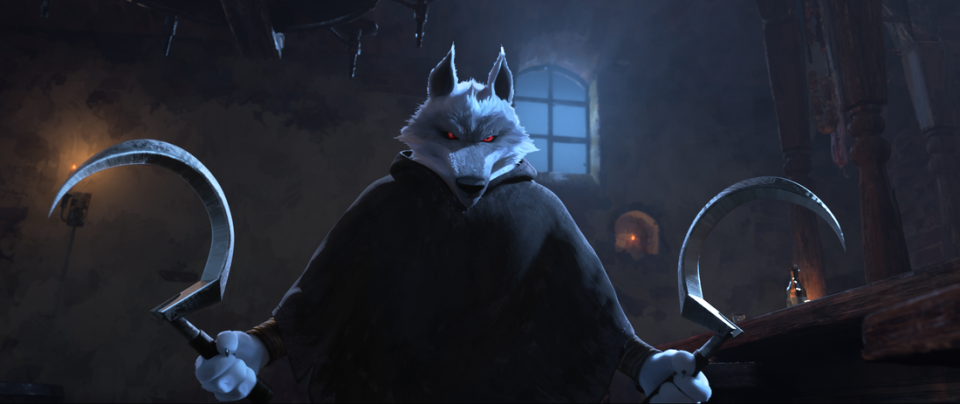‘Puss in Boots: The Last Wish’: Exploring the ‘Undiscovered Territory’ of the Sequel’s Painterly Visuals

- Oops!Something went wrong.Please try again later.
.
The influence and the impact of 2018’s “Spider-Man: Into the Spider-Verse” reverberates far beyond the Oscar-winning superhero adventure’s upcoming sequel: Both of DreamWorks Animation’s current Best Animated Feature contenders traffic in the type of 2D experimentation that was ushered into the mainstream by Miles Morales and his fellow web slingers. For the heist comedy “The Bad Guys,” the studio went with the look of an illustrated book. Meanwhile, “Puss in Boots: The Last Wish” — which finds the fearless feline from the “Shrek” franchise (Antonio Banderas) battling mortality after burning through the first eight of his nine lives — sports a painterly vibe in keeping with its fairy tale trappings.
“At DreamWorks, we had ‘Bad Guys’ pushing in one way, and we went in a different direction, all leading into expanding the toolbox,” “The Last Wish” director Joel Crawford told IndieWire. “So we benefited from some of their R&D and vice versa, mixing some hand-drawn effects with CG. But the other things related to looking like a painting was all undiscovered territory.”
More from IndieWire
Crawford credits production designer Nate Wragg with recommending that they try a more impressionistic approach to reintroduce Puss in Boots, whose last starring vehicle premiered more than a decade ago. This began a look dev process of testing every visual aspect of the production, which, in turn, led to the creation of a new set of tools for fur grooming, shading, lighting, and VFX. “I remember Nate had a paint over of three Puss in Boots,” Crawford said. “One was the classic CG, where you could see every hair on him. Then there was a middle one. And then there was an extreme one that was a flat graphic. But you lost the tangibility. So we did a wedge test to find the right balance, but it didn’t end there.”

Courtesy of DreamWorks Animation
Indeed, the first priority was updating Puss to fit in with this more painterly style, which took a lot of iterations. “This meant that we had to look at every single aspect of what we do across the departments,” added VFX supervisor Mark Edwards. “A lot of that was between surfacing and groom, and then the shader team getting ways to simplify and rendering elements to look like brushstrokes. The trickiest part was still getting the silhouettes they wanted in animation.”
Initially, they pushed too far and it appeared that Puss was losing his iconic look. But this helped the “Puss in Boots” teams develop their tools along the way. In terms of fur grooming, they separated the thicker and sparser guard hairs and made them more illustrative. The idea was to bring out detail when it was required and removed it when it wasn’t. Then they stylistically treated the world around Puss to complement his look, and added 2D work on top of the CG animation.
But because they also wanted the swordplay between Puss and bounty hunter The Wolf (voiced by Wagner Moura) to invoke samurai films and spaghetti Westerns, they went to graphic extremes with stylized choreography, intense lighting, and 2D sprite effects. The standout is the characters’ initial meeting in a cantina, where we first hear the The Wolf whistling an ominous tune (in homage to the films of Sergio Leone) before his dramatic mirror reveal.

Courtesy of DreamWorks Animation
“In visualizing the scene when The Wolf shows up in the [cantina], they pulled graphic lighting from ‘Yojimbo’ with Toshiro Mifune walking through the dust on his own, which served as painterly inspiration,” added Crawford. The Wolf, who is actually The Grim Reaper in disguise, is a step up from the typical DreamWorks baddie. He looks scary in his black hood and brings a real sense of danger. His fur is black and white, highlighted by a diamond-shaped mask, and his eyes are crimson.
“The cantina was an early set and we utilized some new tools and techniques,” said Edwards. “We had a shader option called the stamp map, which allowed us to effectively project whatever brushstrokes or textures onto assets and into whatever channel we wanted as well. So if we just wanted to effect the shading or actual color, we could balance that in with the stamp map. We also had CEO [Crap Encapsulating Objects], which allowed us to break silhouette edges in an interesting artistic way. Then we developed tools around that so surfacing artists could easily get that everywhere on all assets. Any edge in the cantina was broken up with gaps and looked hand-painted with debris floating off the surface.”
At the start of the duel, stepped animation with different frame rates gives the sequence a staccato rhythm, and sparks and streaks were inserted with 2D line work. The Wolf’s dominance was emphasized with red, black, and white, via 2D projection textures, before it becomes totally red. He overpowers Puss with his scythe blades, and even cuts his forehead, which drips blood. This sends Puss fleeing in fear.

Courtesy of DreamWorks Animation
By contrast, the psychedelic-looking rematch at The Wishing Star is fought against a pink field of fire. “It was intense with effects in every shot,” Edwards said. “There was lots of stepped animation going back and forth, quick cuts, and lighting for graphic rhythms.”
“We knew what the nugget of the idea was between Puss in Boots and The Wolf, but we kept building on it to see how far we could go with this painterly style,” Crawford added. “We kept saying, ‘Where do we go from here?’ I remember we were sitting in a screening room and looking at a still image on the screen. We thought it was a painting, and it turned out it was the final image. When they pushed play, we were surprised how it all came together with every department evolving the painterly look. The end result is way better than I pictured it at the beginning.”
Best of IndieWire
Sign up for Indiewire's Newsletter. For the latest news, follow us on Facebook, Twitter, and Instagram.


